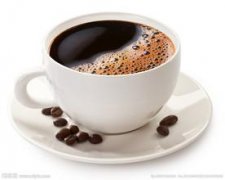A brief introduction to the cultivation of St. Helena coffee beans, geographical location, climate and altitude, which Napoleon begged on his deathbed.

After Napoleon, 26, was appointed commander-in-chief of the Italian Front Army of the French Republic in 1769, he led the army of the French Republic and made many outstanding achievements. But the outstanding record did not bring the great strategist a glorious second half of his life. After the defeat of Russia, the great man fell to the bottom from the peak. After the defeat of Waterloo in 1815, Napoleon completely came to a dead end. after his defeat, Napoleon was sent to exile on St. Helena Island by the British. Napoleon tasted the coffee beans on St. Helena Island.
The Island of St Helena (St. Helena Island)
On May 21, 1502, the Portuguese Admiral Joao da Nova discovered the island of St. Helena. He landed in present-day Jamestown and built a chapel. For more than 80 years, the Portuguese did not make the island public, but used it as a replenishment site for their East Indian fleet.
In 1588, the captain of HMS Desire, an Englishman, Thomas Cavendish, also discovered St. Helena on a voyage around the world, which was often visited by British and Dutch ships. When the Dutch tried to take St. Helena Island for themselves in 1633, the British East India Company began to garrison and established a permanent colony in 1659.
In 1673, the Dutch occupied St. Helena Island, but it was retaken by the British four months later, and the East India Company was granted the right to operate the island until it was directly administered by the British royal family in 1834.
The light is dim
Although St. Helena coffee enjoyed high praise in the 19th century, the popularity did not continue, and even St. Helena Islanders seldom drank it afterwards.
rally
When David R.Henry visited St. Helena in 1986, he was honored to have a taste of the island's coffee with the Governor of St. Helena. This batch of coffee is grown in Plantation House, the Governor's residence on St. Helena Island, where a 260-year-old land turtle also lives, witnessing the origin and long history of St. Helena Coffee.
The source of the seed
On February 10, 1733, a ship from the British East India Company (The East India Company) from the Yemeni port of Moka brought Green Tipped Bourbon Coffee seeds, which began to be planted all over St. Helena and grew luxuriantly, even if neglected.
Once, the French proudly announced to the world that they have their own coffee, which is not from Arabia, but from their native "Bourbon". Their coffee is naturally different from Arabian coffee-round, whether it is intentional or ignorant by the French at that time, and really makes most people think that Bourbon Coffee is really the origin of Bourbon. It was not until the British planted round coffee with the isomorphic characteristics of Bourbon Island that the French lie came to light, because St. Helena's coffee in England had nothing to do with Bourbon Island at all. and the source is actually the same place-Yemen Mocha. Subsequently, this coffee, which was completely different from Tibica, quickly spread to Central and South America with colonial expansion.
Napoleon, as a coffee fanatic, came ashore and lived in Longwude Manor, where he began to write memoirs, dictated by him, and recorded and sorted out by the adjutant brought with him. During his exile from 1815 to 1821, the French dwarf praised St. Helena's coffee, which began to attract the world's attention and became popular in Paris. Beg for St. Helena's coffee before Napoleon's exiled Helena Island is about to die. His adjutant, Marshal Bertrand, said: I can't help but turn red when I see this once awesome man begging for a spoonful of coffee.
A man who has conquered the world is conquered by a cup of coffee and does not forget such a cup of coffee even when he is dying. Perhaps only those who have drunk this cup of coffee can really realize the secret of it, right?
cut a striking figure
When Napoleon was exiled on the island of St. Helena from 1815 to 1821, he praised St. Helena's coffee. St. Helena caffeine began to attract the world's attention and became popular in Paris.
It is becoming popular.
In 1839, Wm Burnie & Co, a London coffee merchant, said: "We introduce St. Helena Coffee to the industry, and its quality and flavor are consistently respected."
In 1845, St. Helena Coffee became the most expensive and unique coffee in the world at a price of 1 pence per pound.
In 1851, coffee grown on St. Helena Island was favored by judges at a coffee exhibition in London (The Great Exhibition).
The present St. Helena
St. Helena Island Coffee Company grows and handles coffee in a rigorous organic way and on its own basis. although it is remote and has not yet obtained official certification for organic cultivation, it is already in progress. St. Helena uses only natural fertilizers and livestock droppings are not used as fertilizers because feed or artificial farming processes may make their faeces contain non-organic matter. St. Helena is lucky to have plenty of bird droppings, which are collected from coastal rocks as natural fertilizer, dried and sprinkled under coffee trees at the beginning of the rainy season. St. Helena uses natural spring water from the mountains to wash and treat coffee beans.
St. Helena Green Tipped Bourbon coffee has a glossy surface after strict standard washing and, after moderate baking, has a bright, soft acidity and strong aroma, with citrus fruit aromas and caramel from Yemeni varieties.
"seeing this once awe-inspiring man now begging for a spoonful of coffee, I can't help but red my eyes." Napoleon adjutant Marshal Bertrand. St. Helena Island is located in the South Atlantic Ocean at longitude 5 °45 'west and latitude 16 °S. The southeast trade wind blows to the island on time every year. Although it covers an area of only 47 square miles, it is an island with a mountainous and subtropical climate. Its remote location preserves the purest ecological environment. On such a volcanic island, many legends were recorded and many beautiful legends were left behind.
In the 15th century, the great navigation era began with the rapid development of world trade. In order to compete for unknown trade opportunities in the world, various explorers were driving their majestic sailboats, adventurous spirits and desirable commodities. Embarked on the voyage of conquering the sea.
In the 17th century, the British discovered coffee as a magical plant as far away as Yemen, and its charm conquered the proud British Empire. In order to get this magical bean, the British learned from France and the Netherlands, and also took the coffee tree from the port of Mocha in Yemen. Smuggled out, south through the Indian Ocean, around the Cape of good Hope of the storm waves to St. Helena Island to plant. Because there is no experience in growing coffee in Holland and France, the coffee planted here grows naturally. At that time, they did not know that the coffee tree they had stolen was another variety-Bourbon.
Important Notice :
前街咖啡 FrontStreet Coffee has moved to new addredd:
FrontStreet Coffee Address: 315,Donghua East Road,GuangZhou
Tel:020 38364473
- Prev

A brief introduction to the treatment method of grinding degree and baking degree of Nicaraguan boutique coffee beans with citrus
Nicaragua is now one of the poorest countries in Central America. Due to its poor economic foundation, the coffee industry is still relatively backward, while coffee farmers are in extreme poverty. Fortunately, Nicaraguan coffee has received some foreign aid funds to improve the quality of its coffee. Coffee from Madagelba, Sinodega and Segovia in Nicaragua
- Next

A brief introduction to the Origin, Development, History and Culture of G1 Fine Coffee beans imported from Lindong Mantenin, Sumatra, Indonesia
The most famous producers of coffee in Asia are the islands of Malaysia: Sumatra, Java and Gary Mann. Sumatra Manning coffee from the Indonesian island of Sumatra is the most famous. Mantenin coffee is produced in Lake dopa in Sumatra Province and Lake Tawa in Aceh. This is the famous Shuangman of the two lakes. What the Shuangman of the two lakes have in common is that they are both very
Related
- Detailed explanation of Jadeite planting Land in Panamanian Jadeite Manor introduction to the grading system of Jadeite competitive bidding, Red bid, Green bid and Rose Summer
- Story of Coffee planting in Brenka region of Costa Rica Stonehenge Manor anaerobic heavy honey treatment of flavor mouth
- What's on the barrel of Blue Mountain Coffee beans?
- Can American coffee also pull flowers? How to use hot American style to pull out a good-looking pattern?
- Can you make a cold extract with coffee beans? What is the right proportion for cold-extracted coffee formula?
- Indonesian PWN Gold Mandrine Coffee Origin Features Flavor How to Chong? Mandolin coffee is American.
- A brief introduction to the flavor characteristics of Brazilian yellow bourbon coffee beans
- What is the effect of different water quality on the flavor of cold-extracted coffee? What kind of water is best for brewing coffee?
- Why do you think of Rose Summer whenever you mention Panamanian coffee?
- Introduction to the characteristics of authentic blue mountain coffee bean producing areas? What is the CIB Coffee Authority in Jamaica?

